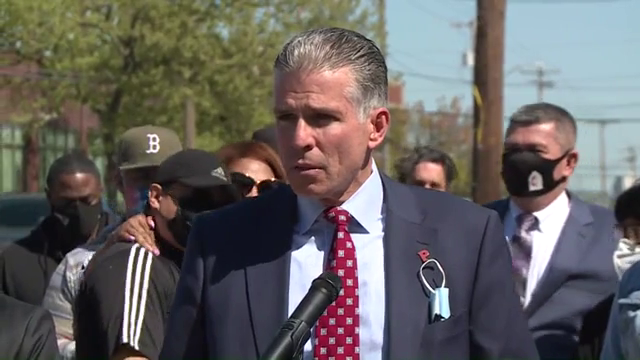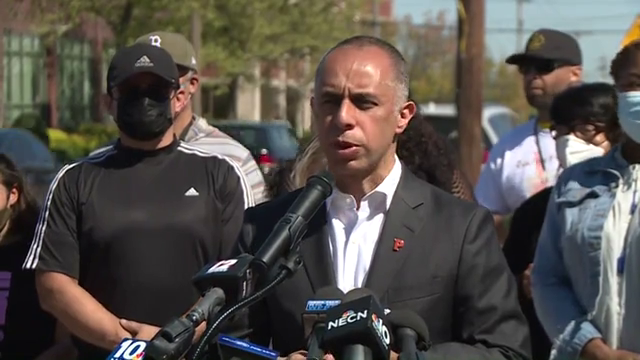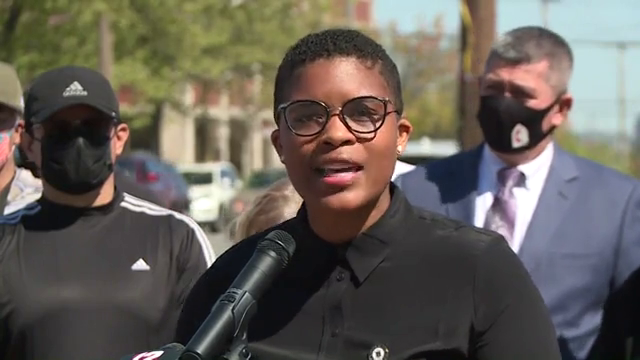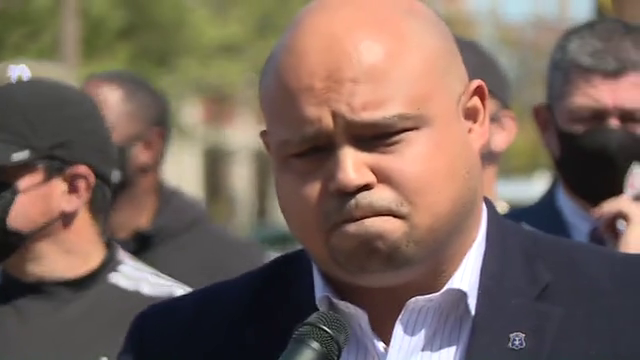As has been widely reported, the worst mass shooting in Providence history occurred last night in the Washington Park neighborhood. At a press conference this morning on Allens Avenue near the scene of the shooting, Public Safety Commissioner Steven Pare provided the details on what he described as an “active criminal investigation.”

“What we do know, and we’ll be identifying those victims later today, there were eight people that were shot. The ninth person was injured by something other than a bullet. We had nine people that were treated. We believe all will recover. There were two that were critical and we believe there’s one that remains in serious condition, but all are expected to recover. Some have been released from the hospital,” Pare said. “We have not brought any criminal charges thus far. We know who all the nine victims are, obviously. We are attempting to identify others that we know that were here. We know there was an exchange of gunfire between one group that had three, possibly five, firearms that drove up in front of 87 Carolina [Avenue], and opened fire on at least three, if not five, individuals that were in and around the porch area. There was a return gunfire by at least two that were in or around 87 Carolina, and as a result there were eight injuries from gunfire.” Pare said all of those injured were between 19 and 25 years old.
Both Mayor Jorge Elorza and Pare identified the primary problem as guns, and there was a sharp break between them and several other speakers at the press conference, including state Sen. Tiara Mack and state Reps. Jose Batista and Grace Dias, who instead said that the main problem is the reasons why people want to shoot each other. The legislators, while acknowledging gun crime as a symptom, pointed to the root causes that drive young adults into social and economic despair.

Elorza focused on gun control. “What happened last night is very clear. There are too many guns and there are too many young people in our community ready to use them. We have to address this issue from both of those angles. We’ve been saying for a long time that we need to stop the flow of guns, illegal or otherwise, onto our streets. I was here last night about a half hour after the incident occurred. I was here a while talking with all of the police officers and almost to a tee, every single officer would tell me the same thing. They would shake their heads and tell me if there are too many guns out there. They told me that even not that long ago – five, six years ago – incidents like this would not happen because there may be a drive-by: maybe one person has a gun, maybe somebody has a revolver who’ll let off a few shots. What happened yesterday, is just something altogether different. Yesterday, there were five, six, maybe even more guns involved, each one of them semi-automatic, and in a matter of seconds we have dozens and dozens and dozens of rounds that are let off in a hail of gunfire. We as a society can’t allow this to happen and we have it in our power to make sure it doesn’t happen. We have called and we will continue to call for comprehensive and also common-sense gun control, to stop the flow of these guns onto our streets.”
Elorza is factually wrong about guns and appears to be confusing “semi-automatic” with “automatic.” I’ve addressed this common misunderstanding in great detail before (“Opinion Guns — The Facts, the History, the Philosophy”, by Michael Bilow, Feb 28, 2018) where I explained, “By federal law, fully automatic weapons have been heavily restricted from civilian use since 1934 and almost totally prohibited since 1986. ‘Semi-automatic’ simply means that, each time the trigger is pulled, one round is fired and the next round is chambered ready for firing: it is the conventional mechanism used in the vast majority of both rifles and handguns since the late 1800s. Nearly all guns in practical use today are semi-automatic.” Whatever “hail of gunfire” occurred was because there were a bunch of people firing from the car and then others firing back from the house, not because any of those guns were especially powerful or exotic.
Pare, avoiding the factual errors committed by his boss, made essentially the same flawed argument. “We have seen most recently, the number of guns and the number of shootings in the city go up pretty drastically. Typically, we’ll have shots fired with one or two or five shell casings. Now we’re finding that it’s typical for people to be shooting at one another or at homes with 20 and 30 shell casings that’s left behind, meaning there were 20 to 30 shots fired in that incident. We do everything to prevent this from happening.” While Pare did not explicitly say the shooting was gang-related, his language clearly left that impression: “These victims from last evening range from 19 years old to 25. These are young adults that are resorting to violence because of feuds on the street. And I’ll echo that there are too many guns that are accessible to too many young adults, and they resort to getting guns and firing at people. Sometimes innocent people get injured, and that needs to stop.”
If Elorza and Pare try to address this as a gun problem, they are doomed to fail. The absolute last people gun control could ever disarm are gang members already enmeshed in criminal activity. Anyone inclined to commit a drive-by shooting is unlikely to comply with restrictive gun laws. It’s also a reasonable inference that the people in the house, if they did in fact return fire, had guns because they felt threatened and therefore needed them for protection, a conclusion borne out by their being attacked in a drive-by shooting. Many of these young adults fully expect not to live long enough to see their 30th birthdays.

Putting the term “violence” in a broader social context, State Sen. Tiara Mack said, “This is a community and we have to recognize that there is also systemic violence, and not just the violence that we talk about that these young people engage in, these children 19 to 25 years old engage in, the violence of a system does not provide our young people, our families, with access to affordable housing, access to clean air, access to drinkable water. These are the systemic violences that this community faces every single day that we fight at the State House, at the city level, for a community to have all of the resources that they need. We are fighting against not just the violence of the streets, but violence of a system that tells us that our communities don’t deserve a living wage, violence of a community that does not afford the opportunities for economic advancement. We cannot just push the blame onto these young people who are a product of a system that has not allowed them to flourish.”
Mack cited the pandemic relief programs at the federal level, which will send money to local governments, as a “once-in-a-lifetime opportunity, with billions of dollars being put into our system to make sure that we have housing, clean air, renewable energy, quality schools in our communities. Right now, Providence public schools are in receivership. We have not seen our young people afforded the opportunities for educational advancement and an opportunity for jobs after they graduate from our schools. These are the problems that our young people face, and it comes out in the violence that we see right here on the street. We should not keep blaming our young people, or too many guns on the street.”

State Rep. Jose Batista spoke in more personal terms. “I have yet to make any sort of statement on this issue just because of how complicated it is. And to me it’s particularly complicated because the one phrase that continues to come to my mind, as I think about the senseless violence that took place just here last night, is ‘There, but for the grace of God, go I.’ I’ve spent my entire life in this community. I may be an elected official now, but even prior to that life, I’m a graduate of the public schools: Roger Williams Middle School, Classical High School. I have friends who are in jail sentences, and in some cases even worse. And rather than repeat so many of the important points that have been made today about policy and politics, the one thing that I think I’m uniquely qualified to talk about is the experience of young people in this community.”
Batista said he was particularly disturbed by “the disregard for life that took place here last night. And I don’t think it matters what political stripe we come from, or what skin color we are, but I think we can all agree that leadership begins with us. And if we want young people, particularly young people in this community, to value their lives, to value lives of each other, then we need to value their lives. We need to affirmatively, aggressively, passionately say their lives matter. It does not get any more simple than that.”
For Batista, he said the issue hits home in more ways than one. “Sadly, my house is four streets that way and this could have been a lot worse. It was indiscriminate. At its core, it was a plea for help. It was a plea for help. I wanted to think about those public schools and what it’s like to actually be in those classrooms, and what it’s like to maybe not feel like you have any options, like you don’t have a future. And I’m telling you, I have been that young person. Today, perhaps I might be celebrated because I have a law degree or because I’m an elected official but when I was 13-14 years old, I promise you, I was not very different from the young people involved in that violence last night. And at every turn, and every thought, I’m going to be thinking about that. I’m not going to be using judgment or lecturing or pontificating. I’m going to think about what was it like for me in my life, when perhaps I didn’t have much value for life either and begin from that point. And if we do that, we can begin to address what happened here last night. The violence may seem random, it may seem like it just happened now, but last night’s violence is the product of decades-long worth of failed policy that Senator Mack did such an excellent job talking about.”
Elorza and Pare would do well to listen to the people from the neighborhoods, such as Mack and Batista, and stop mischaracterizing a problem of social and economic despair as a gun problem: it’s not a gun problem, and it cannot be solved by misguided efforts at gun control. Elorza betrayed the inherent failure of his approach when he said, “we need to stop the flow of guns, illegal or otherwise, onto our streets” (emphasis added) – because he can only stop the legal guns and will never be able to stop the illegal guns wielded by criminals.


